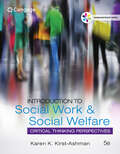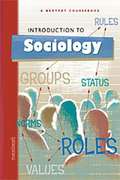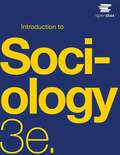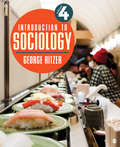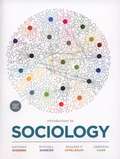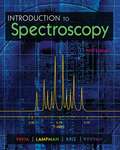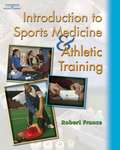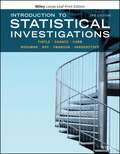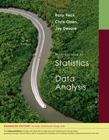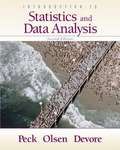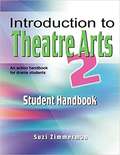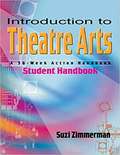- Table View
- List View
Introduction to Social Work and Social Welfare: Critical Thinking Perspectives (Mindtap Course List)
by Karen K. Kirst-AshmanDesigned to give you a solid introduction to the profession of social work, INTRODUCTION TO SOCIAL WORK AND SOCIAL WELFARE, 5th Edition helps you understand the issues that social workers address every day. Using a clear and engaging writing style, author Karen K. Kirst-Ashman presents a balanced overview within a unifying theme of critical thinking that will train you to use evaluative skills in your coursework and beyond. In addition, you'll study more efficiently and effectively with accompanying digital resources that provide you with opportunities to complete self-assessments as well as pre- and post-tests for each chapter. Thoughtful case studies throughout the text help to prepare you for your career by showing you what social work practice looks like in different contexts and with different populations.
Introduction to Sociology
by Barbara G. Cashion Laurence A. Basirico J. Ross EshlemanIntroduction to Sociology Seventh Edition
Introduction to Sociology
by Ethel Wood Judith Lloyd YeroSome of the topics covered in this book are: the world of sociology, culture, social structure & group behavior, socialization, deviance & crime, social stratification & class and race & ethnicity among others
Introduction to Sociology
by OpenStaxIntroduction to Sociology was written by teams of sociology professors and writers and peer-reviewed by college instructors nationwide. The textbook was developed for OpenStax College as part of its Open Educational Resources initiative. This free online text meets standard scope and sequence requirements and incorporates current events such as the Occupy Wall Street movement. The text is designed for the Introduction to Sociology course at any two- to four-year school.
Introduction to Sociology
by OpenStaxIntroduction to Sociology 3e aligns to the topics and objectives of many introductory sociology courses. It is arranged in a manner that provides foundational sociological theories and contexts, then progresses through various aspects of human and societal interactions. The new edition is focused on driving meaningful and memorable learning experiences related to critical thinking about society and culture. The text includes comprehensive coverage of core concepts, discussions and data relevant to a diverse audience, and features that draw learners into the discipline in powerful and personal ways. Overall, Introduction to Sociology 3e aims to center the course and discipline as crucial elements for understanding relationships, society, and civic engagement; the authors seek to lay the foundation for students to apply what they learn throughout their lives and careers. The authors, reviewers, and the entire team worked to build understanding of the causes and impacts of discrimination and prejudice. Introduction to Sociology 3e contains dozens of examples of discrimination and its outcomes regarding social science, society, institutions, and individuals. The text seeks to strike a balance between confronting the damaging aspects of our culture and history and celebrating those who have driven change and overcome challenges. The core discussion of these topics are present in Chapter 11 on Race and Ethnicity, and Chapter 12 on Gender, Sex, and Sexuality, but their causes and effects are extensively discussed in the context of other topics, including education, law enforcement, government, healthcare, the economy, and so on. Together and when connected by an instructor, these elements have potential for deep and lasting effects. This is the official print version of this OpenStax textbook. <P><P>OpenStax makes full-color hardcover and B&W paperback print copies available for students who prefer a hardcopy textbook to go with the free digital version of this OpenStax title. The textbook content is exactly the same as the OpenStax digital book. This textbook is available for free download at the OpenStax dot org website, but as many students prefer to study with hardcopy books, we offer affordable OpenStax textbooks for sale through Amazon as well as most campus bookstores.
Introduction to Sociology (Fifth Edition)
by Laurence A. Bastirico Barbara G. Cashion J. Ross EshlemenIntroductory college textbook on sociology
Introduction to Sociology (Fourth Edition)
by George RitzerThis Fourth Edition of George Ritzer’s Introduction to Sociology shows students the relevance of sociology to their lives. While providing a rock-solid foundation, Ritzer illuminates traditional sociological concepts and theories, as well as some of the most compelling contemporary social phenomena: globalization, consumer culture, the digital world, and the “McDonaldization” of society. With examples on every page from current events and contemporary research to stories about “public” sociologists who are engaging with the critical issues of today, the text demonstrates the power of sociology to explain the world and address the diversity of questions that sociologists seek to answer.
Introduction to Sociology (Seagull 8th Edition)
by Anthony Giddens Richard P. Appelbaum Mitchell Duneier Deborah CarrGiddens (London School of Economics, UK) et al. present a sociology textbook that combines classic theories of the field with empirically-grounded studies and examples from real life to show the basic issues of interest to today's sociologists. The text emphasizes eight themes: the link between micro and macro-level contexts; social change in the world; the globalization of social life; the importance of comparative study; a historical approach; issues of social class, gender, and race; sociological research methods; and the relationship between the social and the personal. Basic concepts are explained within chapters rather than at the beginning of the text. This edition has revised discussion of the sociological imagination and perspective; revised chapters on methods, gender, and aging; and an expanded section on Alzheimer's. Statistics have been updated throughout. Annotation ©2011 Book News, Inc. , Portland, OR (booknews. com)
Introduction to Sociology First Semester FYBA New NEP Syllabus - SPPU
by Dr Jyoti Suhas Gagangras Dr Sudhir Ashruba YevleThe textbook Introduction to Sociology for first-year undergraduate students, aligned with the NEP 2024 syllabus, provides a foundational understanding of sociology as a discipline. It introduces key concepts such as the nature, scope, and significance of sociology, emphasizing the study of human interactions, social structures, and institutions. The book explores the sociological perspective, enabling students to analyze societal patterns and understand cultural diversity. It also examines the role of sociology in addressing social challenges, fostering critical thinking, and contributing to social change. With a focus on practical applications, the textbook highlights the importance of sociology in shaping policies, improving social cohesion, and promoting equity. Designed as a comprehensive resource for students and educators, it combines theoretical insights with real-world examples, making it an essential guide for academic studies and societal understanding.
Introduction to Sociology First Year P.U.C. - Karnataka Board
by Department of Pre-University EducationThe book "Introduction to Sociology" provides a comprehensive overview of sociology as a discipline, exploring the fundamental concepts, theories, and methods used in the study of society. It begins by defining sociology and its significance in understanding the complex nature of human interactions and social structures. The text delves into key topics such as culture, socialization, social institutions, and social stratification, illustrating how these elements shape individual and collective behavior. By examining various sociological perspectives, including functionalism, conflict theory, and symbolic interactionism, the book encourages critical thinking about societal issues and the forces that drive social change. Designed for first-year students, this text serves as an essential foundation for further study in sociology, offering a balanced blend of theoretical insights and practical examples to engage and inform readers.
Introduction to Spectroscopy
by Donald L. Pavia; Gary M. Lampman; George S. Kriz; James R. VyvyanThis proven book provides a systematic introduction to spectra and basic theoretical concepts in spectroscopic methods and includes up-to-date spectra; a modern presentation of one-dimensional nuclear magnetic resonance (NMR) spectroscopy; an introduction to biological molecules in mass spectrometry; and coverage of modern techniques alongside DEPT, COSY, and HECTOR.
Introduction to Sports Medicine and Athletic Training
by Robert C. FranceIntroduction to Sports Medicine & Athletic Training is a book written for individuals interested in athletics and the medical needs of athletes. This book is unique in that it covers four distinct disciplines in an easy to understand format. The four disciplines covered include: Sports Medicine, Athletic Training, Anatomy, and Physiology. This all-in-one resource allows the individual to grasp the concepts of anatomy and physiology, and then apply them to Sports Medicine and Athletic Training. Each discipline is fully presented, and uniquely sequenced together to give the user a full understanding of this exciting field. There are comprehensive chapters on nutrition and sports psychology. Instructors will enjoy the depth of the material covered and the ease in which it is presented. Introduction to Sports Medicine & Athletic Training is the first full-concept book ever written that an entire course can be created around.
Introduction to Statistical Investigations
by George W. Cobb Allan J. Rossman Beth L. Chance Soma Roy Nathan L. Tintle Todd M. Swanson Jill L. VanderStoepThis book leads students to learn about the process of conducting statistical investigations from data collection, to exploring data, to statistical inference, to drawing appropriate conclusions. The authors focus on genuine research studies, active learning, and effective use of technology. In particular, they use simulation and randomization tests to introduce students to statistical inference, yielding a strong conceptual foundation that bridges students to theory-based inference approaches, which are presented throughout the book. This approach allows students to see the logic and scope of inference in the first chapter and to cycle through these ideas. The implementation follows the GAISE recommendations endorsed by the American Statistical Association.
Introduction to Statistical Investigations
by George W. Cobb Allan J. Rossman Beth L. Chance Soma Roy Nathan L. Tintle Todd M. Swanson Jill L. VanderStoepThis book provides a unified framework for explaining variation across study designs and variable types, helping students increase their statistical literacy and appreciate the indispensable role of statistics in scientific research. Requiring only basic algebra as a prerequisite, the program uses the immersive, simulation-based inference approach for which the author team is known. Students engage with various aspects of data collection and analysis using real data and clear explanations designed to strengthen multivariable understanding and reinforce concepts. <p><p> Each chapter follows a coherent six-step statistical exploration and investigation method (ask a research question, design a study, explore the data, draw inferences, formulate conclusions, and look back and ahead) enabling students to assess a variety of concepts in a single assignment. Challenging questions based on research articles strengthen critical reading skills, fully worked examples demonstrate essential concepts and methods, and engaging visualizations illustrate key themes of explained variation. The end-of-chapter investigations expose students to various applications of statistics in the real world using real data from popular culture and published research studies in variety of disciplines. Accompanying examples throughout the text, user-friendly applets enable students to conduct the simulations and analyses covered in the book.
Introduction to Statistics and Data Analysis
by Roxy Peck Chris Olsen Jay DevoreThis book introduces you to the study of statistics and data analysis by using real data and attention-grabbing examples. The authors guide you through an intuition-based learning process that stresses interpretation and communication of statistical information. They help you grasp concepts and cement your comprehension by using simple notation-frequently substituting words for symbols. You will also find coverage of the graphing calculator as a problem-solving tool, plus hands-on activities in each chapter that allow you to practice statistics firsthand.
Introduction to Statistics and Data Analysis (2nd Edition)
by Roxy Peck Chris Olsen Jay DevoreThis high school textbook is designed to conform to the syllabus of the Advanced Placement Statistics course. Featuring simplified notation as well as coverage of advanced topics such as multiple regression, the text can be used in quarter or year-long courses. The text begins with an overview of the data analysis process from planning through interpretation of results, and then presents material according to the sequence of the data analysis process, with sections on collecting data and descriptive methods, probability, basic one- and two-sample inferential techniques, and more advanced inferential methodology. Most chapters include a section on interpreting and communicating results. Most exercises and activities involve real data from journal articles and other published sources, highlighting applications in many disciplines, such as college life, leisure and popular culture, medical science, social issues, and sports. A companion website offers graphic calculator instructions, plus data sets and applets for activities. This fourth edition contains 50 new examples and 270 new exercises. About 90 exercises now have video solutions online for download. Peck is affiliated with California Polytechnic State University. Annotation ©2012 Book News, Inc. , Portland, OR (booknews. com)
Introduction to Statistics and Data Analysis (Fifth Edition)
by Roxy Peck Chris Olsen Jay L. DevoreRoxy Peck, Chris Olsen, and Jay Devore's new edition uses real data and attention-grabbing examples to introduce students to the study of statistics and data analysis. Traditional in structure yet modern in approach, this text guides students through an intuition-based learning process that stresses interpretation and communication of statistical information. Simple notation--including frequent substitution of words for symbols--helps students grasp concepts and cement their comprehension. Hands-on activities and interactive applets allow students to practice statistics firsthand. INTRODUCTION TO STATISTICS AND DATA ANALYSIS includes updated coverage of most major technologies, as well as expanded coverage of probability.
Introduction to Statistics and Data Analysis, AP® Edition
by Roxy Peck Chris Olsen Jay L. DevoreNIMAC-sourced textbook
Introduction to Teaching: Becoming a Professional (Fifth Edition)
by Don Kauchak Paul EggenThe best-selling case-based text, Introduction to Teaching: Becoming a Professional, sharpens its focus on issues in education in its Fifth Edition. Weaving this focus throughout every chapter with new features and chapter sections covering diversity, reform, urban education, and technology, the text ensures that prospective teachers gather all the needed information to create an up-to-date picture of the ever changing face of education. The authors take this information and bring it to life with cases, classroom examples and videos, again ensuring that the living, changing, challenging and fulfilling life of an educator is as clear as it can be.
Introduction to Theatre Arts 2: An Action Handbook for Drama Students
by Suzi ZimmermanThose who have already discovered the ease of teaching Theatre Arts with Suzi Zimmerman's first textbook will be thrilled to learn she has come out with this sequel! <p><p> This action handbook takes all the outstanding components you loved in the first book and applies it to seven new sections: 1. Theatre for Life s Lessons, 2. Movement Theatre for the Eyes, 3. Voice Theatre for the Ears, 4. Skill-Building Activities Theatre Projects, Mini-Units and Self-Guided Lessons, 5. Understanding and Writing Scripts, 6. Theatre Behind the Scenes, and 7. Production 101. Theory combined with hands-on is the style of every chapter. This series has been classroom-tested to fit the budgetary considerations of all schools.
Introduction to Theatre Arts: A 36-Week Action Handbook
by Suzi ZimmermanAt last! A student-friendly, teacher-friendly workbook with study units for a full year of classroom drama activities. <p><p> The entire spectrum of theatre is covered in ten sections: 1. Getting Started, 2. Evaluation, 3. Scene Work, 4. Acting, 5. Characterization, 6. Publicity and Other Production Business, 7. Play Production, 8. Theatre History, 9. Games and Improvisation, 10. Planning for the Future. All units are complete with detailed instructions, examples, working forms, and photo illustrations. Students will learn all the basics of theatre history, play production, performing, and finding a career in theatre. This instructional program is classroom-tested and designed to fit the budgetary considerations of schools.
Introduction to Three-Dimensional Climate Modeling
by Warren WashingtonMost descriptions of climatic modeling assume readers to have a great deal of previous knowledge about atmospheric or ocean dynamics, but Washington (US National Center for Atmospheric Research) and Parkinson (US National Aeronautics and Space Administration) address readers in the atmospheric science, geography, geology, hydrology, oceanography, and ecology who may be only vaguely aware of climate models. They explain what the models are attempting to simulate, how they are constructed, what they have succeeded in simulating, and how they are being used for evaluation and prediction. Annotation ©2005 Book News, Inc. , Portland, OR (booknews. com)
Introduction to Topology: Third Edition
by Bert MendelsonHighly regarded for its exceptional clarity, imaginative and instructive exercises, and fine writing style, this concise book offers an ideal introduction to the fundamentals of topology. Originally conceived as a text for a one-semester course, it is directed to undergraduate students whose studies of calculus sequence have included definitions and proofs of theorems. The book's principal aim is to provide a simple, thorough survey of elementary topics in the study of collections of objects, or sets, that possess a mathematical structure.The author begins with an informal discussion of set theory in Chapter 1, reserving coverage of countability for Chapter 5, where it appears in the context of compactness. In the second chapter Professor Mendelson discusses metric spaces, paying particular attention to various distance functions which may be defined on Euclidean n-space and which lead to the ordinary topology. Chapter 3 takes up the concept of topological space, presenting it as a generalization of the concept of a metric space. Chapters 4 and 5 are devoted to a discussion of the two most important topological properties: connectedness and compactness. Throughout the text, Dr. Mendelson, a former Professor of Mathematics at Smith College, has included many challenging and stimulating exercises to help students develop a solid grasp of the material presented.
Introduction to Web Design Using Dreamweaver
by Mark A. Evans Michael HammThis book intends to help the reader develop skills needed to become a Web designer and other useful skills like critical thinking and teamwork skills.
